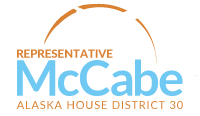Friends & Neighbors In The Mat-Su
Thank you for all of your support; it is a privilege to serve you.
I believe our communities need engaged and energetic representation. As your representative for House District 30 (covering Big Lake, Point Mackenzie, Houston, Petersville, Cantwell, Healy, Denali Park, Clear and Anderson) I am working hard on the issues important to our communities.
Your Representative
For The People of District 30, and Alaska
Meet Kevin
Retired from the U.S. Coast Guard, Kevin has lived in Alaska for most of the past 40 years. He currently flies Boeing 747s for a major international air cargo airline, and serves District 30 in the State House. Together with wife Linn, Kevin lives in the Big Lake community and is blessed with children and grandchildren nearby…
The Issues
There are myriad issues that concern you and your family, friends and co-workers. Healthcare costs, education metrics, roads and transportation, resource and economic development, possible new taxes, and of course our Permanent Fund – all are important. Kevin has these same concerns and hopes to represent you…
Support
Kevin is active and invested in making a real difference for Alaskans. As Representative for District 30, he does not pursue the job for any personal gain, but because he believes the direction of the state government needs to change. Show your support by letting him know what’s important to you!
LATEST ARTICLES
The Right To Personhood
In Roe v. Wade, Justice Potter Stewart asked the pro-abortion attorney Sarah Weddington this question: “If it were established that an unborn fetus is a person within the protection of the Fourteenth Amendment, you would have an almost impossible case here would you not?”...
Transforming our Alaska education system
In Alaska, public funds for education seem to be used to establish both public and private kingdoms. These bureaucracies have taken on a life of their own. They are structured to fund their own survival, not educate our rapidly failing student population...




